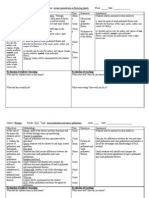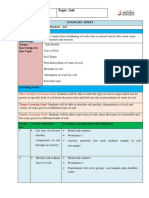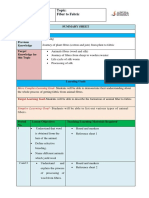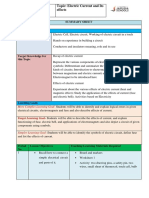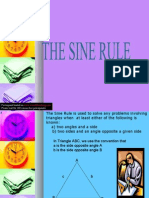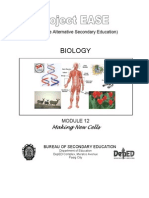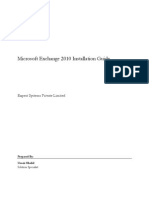83%(12)83% found this document useful (12 votes)
21K viewsChanges Around Us
Changes Around Us
Uploaded by
api-19979730This document discusses different types of changes. It aims to make students aware of changes around them, understand why changes occur, and motivate students to minimize changes that negatively impact people or the environment. The document defines change and describes slow and fast changes, desirable and undesirable changes, reversible and irreversible changes, periodic and non-periodic changes, and physical and chemical changes. Students are given examples of each type of change.
Copyright:
Attribution Non-Commercial (BY-NC)
Available Formats
Download as PPT, PDF, TXT or read online from Scribd
Changes Around Us
Changes Around Us
Uploaded by
api-1997973083%(12)83% found this document useful (12 votes)
21K views20 pagesThis document discusses different types of changes. It aims to make students aware of changes around them, understand why changes occur, and motivate students to minimize changes that negatively impact people or the environment. The document defines change and describes slow and fast changes, desirable and undesirable changes, reversible and irreversible changes, periodic and non-periodic changes, and physical and chemical changes. Students are given examples of each type of change.
Original Title
Changes around us
Copyright
© Attribution Non-Commercial (BY-NC)
Available Formats
PPT, PDF, TXT or read online from Scribd
Share this document
Did you find this document useful?
Is this content inappropriate?
This document discusses different types of changes. It aims to make students aware of changes around them, understand why changes occur, and motivate students to minimize changes that negatively impact people or the environment. The document defines change and describes slow and fast changes, desirable and undesirable changes, reversible and irreversible changes, periodic and non-periodic changes, and physical and chemical changes. Students are given examples of each type of change.
Copyright:
Attribution Non-Commercial (BY-NC)
Available Formats
Download as PPT, PDF, TXT or read online from Scribd
Download as ppt, pdf, or txt
83%(12)83% found this document useful (12 votes)
21K views20 pagesChanges Around Us
Changes Around Us
Uploaded by
api-19979730This document discusses different types of changes. It aims to make students aware of changes around them, understand why changes occur, and motivate students to minimize changes that negatively impact people or the environment. The document defines change and describes slow and fast changes, desirable and undesirable changes, reversible and irreversible changes, periodic and non-periodic changes, and physical and chemical changes. Students are given examples of each type of change.
Copyright:
Attribution Non-Commercial (BY-NC)
Available Formats
Download as PPT, PDF, TXT or read online from Scribd
Download as ppt, pdf, or txt
You are on page 1of 20
At a glance
Powered by AI
The text discusses several concepts and their relationships across multiple pages in detail.
The main topics discussed include concepts, their definitions, applications and interrelationships.
The information is presented in a logical flow, first introducing concepts, then explaining them and finally showing how they are connected.
Changes Around Us
Objectives
To make the students aware about the
various changes around us.
To make the students understand the
reasons behind the changes.
To motivate students to minimize changes
which adversely affect us or our
environment.
Contents
What is change?
Types of changes.
Slow and fast changes
Desirable and undesirable changes
Reversible and irreversible changes
Periodic and non periodic changes
Physical and chemical changes
Conclusion
What is change?
Every day we observe
changes around us. For
example the change of
day and night, flowering
of plants, ripening of
fruits, rainfall etc.
Change is the transition of any substance
from one form to another.
Types of changes
Slow and fast changes
Desirable and undesirable changes
Reversible and irreversible changes
Periodic and non periodic changes
Physical and chemical changes
Slow Changes
Slow changes are those which take a long time
to occur. For example the germination of seed
to form plant, growth of child into an adult and
further into an old man, rusting of iron etc.
Fast Changes
Fast changes take
less time to occur or
Occur
instantaneously.
For example burning
of paper, bursting of
balloon, burning of
matchstick.
Desirable Changes
There are some changes which occur as
we wish. We like such changes that is why
these are called desirable changes. For
example formation of curd from milk,
formation of manure from cow dung and
dead plants.
Undesirable changes
There are some changes
which do not occur as per
our wishes. Such changes
are called undesirable
changes. For example
earthquakes, excessive
heat in due to rise in
temperature in summers
and breaking of glass.
Sometimes undesirable
changes accompany
desirable changes
The running of car on
road is desirable but
it also produces
smoke, carbon
dioxide and other
harmful gases which
pollute the
environment. Hence
it becomes the
undesirable change.
Some changes may be
desirable for one person but
undesirable for others.
For example the cutting of
tree may be may be
desirable for one who
needs wood but
undesirable for others
because it disturbs the
balance in nature as trees
produce oxygen which is
necessary for all human
beings on earth.
Periodic Changes
Changes which occur again
and again after fixed
intervals of time are known
as periodic changes. For
example change of day
and night, occurrence of
full moon, heart beat and
oscillation of pendulum of
clock.
Non-Periodic changes
There are some changes
which do not repeat
themselves at regular
intervals. You can not
predict when they will
reoccur.
For example occurrence of
earthquake, train
accidents, sneezing,
rusting of iron etc.
Reversible Changes
If a change can be reversed then it is called
reversible change. For example on cooling
water to the freezing point it changes into ice
and ice changes back into water on heating.
Irreversible Changes
There are some changes which can not be reversed
such changes are called irreversible. For example
growth of child into an adult and then from an adult
to an old man.
Physical Changes
Changes in which Water
size or shape of the vapours
object may change
but the substance of
which they are made
of remain the same.
For example
formation of water
vapours on heating
water.
Chemical Changes
The changes in which new substances are
formed are called chemical changes. For
example rusting of iron lead to formation of
iron oxide.
2Fe + O2 --------->2FeO
Iron Oxygen Rust
We can not get back iron or oxygen from
iron
oxide. So it is a chemical change.
Conclusion
We should try to minimize changes
which adversely affect the human
beings or their environment.
For example: Cutting of trees,
Pollution etc.
Exercise
Tell which type of change is this:
Growing of a plant from a seed.
Evaporation of water.
Occurring of tides in the sea.
Revolving of earth around the sun.
References
Text book of class 6th.
Dinesh Simplified Science and
Technology (Chemistry)
Google search.
Yahoo search.
You might also like
- 3rd Class EVS Lesson PlansDocument39 pages3rd Class EVS Lesson Plansjp tech100% (1)
- Lesson Plan Class 7Document4 pagesLesson Plan Class 7Obul Reddy Polimera100% (2)
- Class 5 EVS-L-1, Lesson PlanDocument1 pageClass 5 EVS-L-1, Lesson Planjs k82% (22)
- Lesson Plan of Nutrition in PlantsDocument4 pagesLesson Plan of Nutrition in PlantsPushpa Kumari100% (11)
- Life Processes Lesson PlanDocument10 pagesLife Processes Lesson PlanSUMAN RAWAT50% (2)
- 5 E Approach Based Lesson Plan - Chapter - 1 - Food - Where Does It Come From? - NCERT - CBSE - CLASS 6th - ScienceDocument27 pages5 E Approach Based Lesson Plan - Chapter - 1 - Food - Where Does It Come From? - NCERT - CBSE - CLASS 6th - ScienceLesson Planner DP100% (5)
- Class IX Science Why Do We Fall Ill - Lesson Plan PDocument16 pagesClass IX Science Why Do We Fall Ill - Lesson Plan PShailaja Mestry0% (2)
- Lesson Plan For Reproduction in PlantsDocument7 pagesLesson Plan For Reproduction in Plantscsamarina71% (7)
- Detailed Lesson Plan of Class VI-ScienceDocument5 pagesDetailed Lesson Plan of Class VI-ScienceJanette Fernandez Villanueva88% (8)
- Lesson Plan Viii Chapter 7Document3 pagesLesson Plan Viii Chapter 7Amaterasu Susanoo Tsukuyomi100% (1)
- Lesson Plan Class VIIDocument4 pagesLesson Plan Class VIIPushpa Kumari50% (2)
- Class:7 Subject: Science Topic: Winds Storms and Cyclones: Summary Sheet Pedagogical Approach: Student - LedDocument15 pagesClass:7 Subject: Science Topic: Winds Storms and Cyclones: Summary Sheet Pedagogical Approach: Student - LedManpreet Kaur100% (4)
- Class - Viii Lesson Plan Chapter 9-Reproduction in Animals: Students Will Be Able ToDocument14 pagesClass - Viii Lesson Plan Chapter 9-Reproduction in Animals: Students Will Be Able ToManpreet Kaur100% (4)
- Class:7 Subject: Science Topic: Weather, Climate and Adaptation of Animals To ClimateDocument11 pagesClass:7 Subject: Science Topic: Weather, Climate and Adaptation of Animals To ClimateManpreet KaurNo ratings yet
- Earthquake Preparedness For SGsDocument22 pagesEarthquake Preparedness For SGsEd Cabrera100% (1)
- Class: 6 TOPIC: Bridge Course (Ch-2. Components of Food) Learning OutcomesDocument3 pagesClass: 6 TOPIC: Bridge Course (Ch-2. Components of Food) Learning OutcomesKavitha K0% (1)
- 7th Physical and Chemical Changes Lesson PlanDocument2 pages7th Physical and Chemical Changes Lesson PlanAnkita Diver100% (2)
- Class:7 Subject: Science Topic: Soil: Summary Sheet Pedagogical Approach: Student - LedDocument16 pagesClass:7 Subject: Science Topic: Soil: Summary Sheet Pedagogical Approach: Student - LedManpreet KaurNo ratings yet
- Lesson Plan-2-Components of Food-Class 6Document7 pagesLesson Plan-2-Components of Food-Class 6Manasa Priyanka100% (1)
- Class 6 Lesson Plan LivingDocument10 pagesClass 6 Lesson Plan LivingHIRAL SOLANKINo ratings yet
- Lesson Plan - Digital Pedagogy Grade 8 Week 3Document6 pagesLesson Plan - Digital Pedagogy Grade 8 Week 3shamshadNo ratings yet
- Bamboo: Class: Class 7 - Section A Subject: Science Chapter: Nutrition in Plants TitleDocument2 pagesBamboo: Class: Class 7 - Section A Subject: Science Chapter: Nutrition in Plants TitleArvind Murali50% (2)
- VI-11-Light, Shadows and ReflectionsDocument16 pagesVI-11-Light, Shadows and ReflectionsPHYSICS HACK100% (2)
- 6 - Science - All - Lesson Plan PDFDocument138 pages6 - Science - All - Lesson Plan PDFRubab ShaikhNo ratings yet
- Air Around UsDocument5 pagesAir Around UsRubab ShaikhNo ratings yet
- 8.5 - Coal and PetroleumDocument12 pages8.5 - Coal and PetroleumSayantan Pahari CreationsNo ratings yet
- Jadhav Sir - Class VI Chapter 10 - Motion and Measurement of DistancesDocument7 pagesJadhav Sir - Class VI Chapter 10 - Motion and Measurement of DistancesJoshua Hicks100% (2)
- Lesson Plan Mangoes Round The YearDocument2 pagesLesson Plan Mangoes Round The YearSanthanalakshmiNo ratings yet
- Lesson Plan Class 6 CH Magnet Day 1Document8 pagesLesson Plan Class 6 CH Magnet Day 1Ujjwal Kr. SinhaNo ratings yet
- Class 5 EVS-L-5Document2 pagesClass 5 EVS-L-5DHISHNA KHAJURIANo ratings yet
- Class 7 Subject: Science Topic: Fiber To Fabric: Summary SheetDocument11 pagesClass 7 Subject: Science Topic: Fiber To Fabric: Summary SheetManpreet KaurNo ratings yet
- General and Specific Objectives-Combustion and FlamesDocument2 pagesGeneral and Specific Objectives-Combustion and FlamesSubha Dey75% (4)
- Lesson Plan Class VIII - Coal and PetroleumDocument4 pagesLesson Plan Class VIII - Coal and PetroleumPushpa Kumari100% (2)
- Air Around Us With InnovationsDocument7 pagesAir Around Us With InnovationsbittuchintuNo ratings yet
- Separation of Mixtures Class 9Document6 pagesSeparation of Mixtures Class 9Pushpa Kumari100% (1)
- Food Lesson Plan FINALDocument16 pagesFood Lesson Plan FINALSagarika MishraNo ratings yet
- Biology-04 - Improvement in Food ResourcesDocument4 pagesBiology-04 - Improvement in Food ResourcesMonika Mehan100% (1)
- Synthetic Fibres & Plastics Class 8Document3 pagesSynthetic Fibres & Plastics Class 8Pushpa KumariNo ratings yet
- CombustionDocument16 pagesCombustionDipikaNo ratings yet
- LP of 8 Class CH - Synthetic Fibre and PlasticsDocument8 pagesLP of 8 Class CH - Synthetic Fibre and PlasticsarchanaNo ratings yet
- Measurement and MotionDocument6 pagesMeasurement and Motionbittuchintu100% (1)
- Lesson Plan - VI ScienceDocument4 pagesLesson Plan - VI Sciencesonia singh100% (3)
- CH-15 Improvement in Food ResourcesDocument26 pagesCH-15 Improvement in Food ResourcesSagarika MishraNo ratings yet
- Lesson Plan 7th-DIGESTION IN ANIMALSDocument3 pagesLesson Plan 7th-DIGESTION IN ANIMALSAnkita Diver100% (4)
- Science Yearly Plan For Grade 7Document5 pagesScience Yearly Plan For Grade 7shaheen ansari0% (1)
- Lesson Plan Class 6 CH Magnet Day 3Document8 pagesLesson Plan Class 6 CH Magnet Day 3Ujjwal Kr. Sinha100% (2)
- LP GR 7 CH 9 SoilDocument5 pagesLP GR 7 CH 9 Soilanju singh100% (1)
- Class:7 Subject: Science Topic: Electric Current and Its EffectsDocument24 pagesClass:7 Subject: Science Topic: Electric Current and Its EffectsManpreet KaurNo ratings yet
- Class 8 Annual PlannerDocument3 pagesClass 8 Annual PlannerHimanshu100% (1)
- Human Eye and Colorful World-10th Class Lesson PlanDocument7 pagesHuman Eye and Colorful World-10th Class Lesson PlanNiranjan Unique100% (1)
- Lesson Plan Class 6 CH Electricity and Circuit Day 2Document8 pagesLesson Plan Class 6 CH Electricity and Circuit Day 2Ujjwal Kr. SinhaNo ratings yet
- Water A Precious Resource - Lesson Plan 2 15oct18Document14 pagesWater A Precious Resource - Lesson Plan 2 15oct18shashi kumar100% (2)
- Lesson Plan CH 5 Body MovementDocument11 pagesLesson Plan CH 5 Body MovementHIRAL SOLANKINo ratings yet
- Lesson Plan: Subject Science Class - Viii No. of Periods Required: 5 Lesson To Be Taught My FocusDocument1 pageLesson Plan: Subject Science Class - Viii No. of Periods Required: 5 Lesson To Be Taught My FocusManpreet Kaur100% (1)
- Lesson Plan VIII CellDocument2 pagesLesson Plan VIII CellShital KotkarNo ratings yet
- Class 5 Evs Lesson PlanDocument32 pagesClass 5 Evs Lesson PlanSHIVANGI RAJPUT50% (2)
- Changes Around Us Science - Class-ViDocument28 pagesChanges Around Us Science - Class-ViAmit SharmaNo ratings yet
- CHEMISTRY-C2-G7 Physical and Chemical Changes SummaryDocument3 pagesCHEMISTRY-C2-G7 Physical and Chemical Changes SummaryanupamNo ratings yet
- Changes Around Us NotesDocument5 pagesChanges Around Us NotesMohit ThakurNo ratings yet
- Physical and Chemical ChangesDocument3 pagesPhysical and Chemical ChangesAbhyudaya SharmaNo ratings yet
- Exp SC 6 - Chapter 06Document11 pagesExp SC 6 - Chapter 06megamind publicationNo ratings yet
- The Sine and Cosine RuleDocument17 pagesThe Sine and Cosine Ruleapi-19979730No ratings yet
- Circleterminology OptDocument15 pagesCircleterminology Optapi-19979730No ratings yet
- Algebra II: by MonicaDocument21 pagesAlgebra II: by Monicaapi-19979730No ratings yet
- Class 9Th: Bir Sikhan Wala FaridkotDocument22 pagesClass 9Th: Bir Sikhan Wala Faridkotapi-19979730No ratings yet
- Welcome To Presentation On: PunctuationDocument43 pagesWelcome To Presentation On: Punctuationapi-19979730No ratings yet
- I Am Poem AssignmentDocument5 pagesI Am Poem AssignmentTheresa IlanoNo ratings yet
- LG Air Conditioner Error CodesDocument15 pagesLG Air Conditioner Error CodesPaulo Marques SilvaNo ratings yet
- Introduction To SterilizationDocument6 pagesIntroduction To SterilizationImran KhanNo ratings yet
- Pox VirusDocument8 pagesPox VirusDayana PrasanthNo ratings yet
- English Test of SpellingDocument13 pagesEnglish Test of SpellingmudassirjNo ratings yet
- Yulanda M. Faris Young Artists Program - Vancouver Opera: Application FormDocument2 pagesYulanda M. Faris Young Artists Program - Vancouver Opera: Application FormPaula BerryNo ratings yet
- Bishop Scharfenberger Statement - March 1, 2020Document1 pageBishop Scharfenberger Statement - March 1, 2020Exsar ArguelloNo ratings yet
- Housing of Labour Workers On Sugar EstatesDocument3 pagesHousing of Labour Workers On Sugar EstatesMarkAminNo ratings yet
- Open Charge Point Protocol SOAP 1.6, OCPP-S 1.6 SpecificationDocument14 pagesOpen Charge Point Protocol SOAP 1.6, OCPP-S 1.6 SpecificationAulia NaufalNo ratings yet
- Limiting Reactants Notes HandoutDocument9 pagesLimiting Reactants Notes Handoutapi-376281962No ratings yet
- Week 8 PowerPoint Slide NotesWeek 8 Tim 8530Document15 pagesWeek 8 PowerPoint Slide NotesWeek 8 Tim 8530m8thmilitantNo ratings yet
- DGCA Class 1 MedicalDocument6 pagesDGCA Class 1 MedicalPhani MamillaNo ratings yet
- Rob, S - Dragon MagicDocument27 pagesRob, S - Dragon MagicMike Cedersköld33% (3)
- Module Two Wellness Plan 1Document4 pagesModule Two Wellness Plan 1s11883758No ratings yet
- CMDQ ValidationDocument10 pagesCMDQ ValidationDavid DizonNo ratings yet
- Java Unit 1 - 23410733 - 2023 - 11 - 22 - 12 - 40Document37 pagesJava Unit 1 - 23410733 - 2023 - 11 - 22 - 12 - 40Aman JaiswalNo ratings yet
- Biology M12 Making New CellsDocument27 pagesBiology M12 Making New CellsJoshua Apilado100% (2)
- Turbine Modification of Nuovo Pignone Gas TurbineDocument4 pagesTurbine Modification of Nuovo Pignone Gas Turbinecaballero95250100% (2)
- Exchange 2010 Installation ManualDocument15 pagesExchange 2010 Installation Manualumair_awan_6No ratings yet
- Role of Biotechnology in Creating Sustainable AgricultureDocument13 pagesRole of Biotechnology in Creating Sustainable AgricultureRuthNo ratings yet
- Chromatic Mediant RelationshipsDocument1 pageChromatic Mediant Relationshipsrogeriomenegaz100% (2)
- PreviewDocument29 pagesPreview2031Aditi KachareNo ratings yet
- Irumbile Oru Idhaiyam Song LyricsDocument1 pageIrumbile Oru Idhaiyam Song LyricsjokerxffindNo ratings yet
- Self-Checkout Case StudyDocument4 pagesSelf-Checkout Case StudyAishvarya GuptaNo ratings yet
- GQ Ball Pen Industries LTDDocument10 pagesGQ Ball Pen Industries LTDKhaled Hasan KhanNo ratings yet
- Assignment On Ion Exchange in Soil: Instructor: Student: Id: Section: SemesterDocument4 pagesAssignment On Ion Exchange in Soil: Instructor: Student: Id: Section: SemesterUsman GhaniNo ratings yet
- Rust Prevention PDFDocument6 pagesRust Prevention PDFAliakbar GhaderiNo ratings yet
- United We StandDocument3 pagesUnited We StandTeo Bee CheemNo ratings yet
- AOCS Recommended Practice Ca 12-55 Phosphorus PDFDocument2 pagesAOCS Recommended Practice Ca 12-55 Phosphorus PDFWynona Basilio100% (1)







